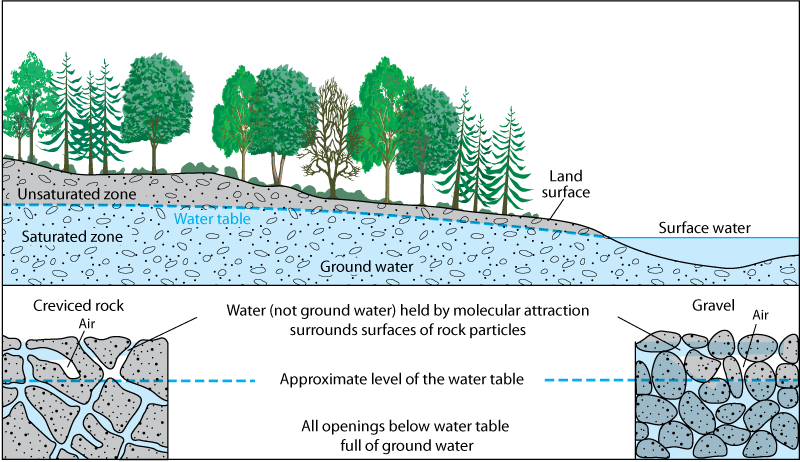Where does groundwater come from?
September 9, 2015We talk a lot about groundwater, but it’s been a while since we’ve explained what, exactly, it is.
According to the U.S. Geological Survey, there’s ground water pretty much everywhere on earth. It varies in amount and in distance from the surface. “The water table may be deep, such as under a hillside, or shallow such as under a valley. The water table may rise or fall depending on several factors,” USGS states.
Those “several factors” include groundwater-recharging rain and snowmelt, and drought — which can cause the water table to drop.
When rain falls, or snow melts, a portion of the liquid follows the ground’s surface until it finds its way into streams and lakes. Some of that surface water will evaporate (like the mist that rises off hot roads after a storm) and return to the clouds. Some of it sinks into the ground, getting trapped by soil, rocks or roots until a plant sucks it up (and later releasing some of it into the air again through transpiration), and some of it sinks even farther.

It “moves downward through empty spaces or cracks in the soil, sand, or rocks until it reaches a layer of rock through which water cannot easily move. The water then fills the empty spaces and cracks above that layer,” the USGS states. “The top of the water in the soil, sand, or rocks is called the water table and the water that fills the empty spaces and cracks is called ground water.”
Soil and rock that lets water pass through easily is called the aquifer. “Aquifers typically consist of gravel, sand, sandstone, or fractured rock such as limestone,” USGS states. Clay or shale aren’t good aquifer materials because they slow or stop the passage of water.
Why is groundwater so important? Because, for one thing, so many of us use it for drinking, bathing, irrigation and more. LCA uses a number of wells that tap into groundwater supplies. The USGS states that more than half of all the people in this country use groundwater, and about three-quarters of the nation’s cities and businesses use it as well.
Because our groundwater is such a valuable resource, it’s important to conserve it as well as protect it from pollution. As the USGS points out, it can become contaminated just like any other water source: seepage from landfills, from septic tanks, from leaky underground fuel tanks, and from fertilizers or pesticides.
Next time you take a drink, water the lawn or take a shower, consider the journey the water took before it got to your house!